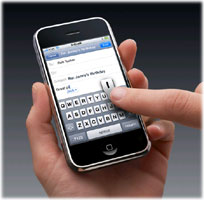The latest mobile phone handsets provide a wide range of services and technology that allows the user to be as interactive as possible with the global community. These new mobile technologies offer the user accessibility to the worldwide web via WiFi connectivity, download and transfer large amounts of data via high speed connectivity and find a location via satellite with mobile Global Positioning Systems (GPS) devices.
Todays mobile phones have now evolved to incorporate all types of online activity, here is a little breakdown of some of the latest technology to grasp the mobile market.
WiFi TechnologyWhat is Wi-Fi?WiFi is a wireless technology brand owned by the Wi-Fi Alliance intended to improve the operating of wireless products. Common applications for Wi-Fi include Internet and VoIP phone access, gaming, and network connectivity for consumer electronics such as mobile phones, laptops, game consoles, MP3 players and PDA's. Wi-Fi also allows connectivity which enables devices to connect directly with each other. This connectivity mode is useful in consumer electronics and gaming applications. It's faster and has a greater range than Bluetooth, and is ideal for home or office connectivity. In the near future, wireless networking may become so widespread that you can access the Internet just about anywhere at any time, without using wires. The easy access of emails for business orientated individuals is also a bonus, as urgent messages can be downloaded on the go once the email settings are configured on to the WiFi enabled handset. |  |
| The mobile phones market has received a lot of attention lately as several operators across the world have launched various types of handsets which allow users to connect to the Internet via Wi-Fi, the iPhone being the ultimate example. | |
Mobile VoIP
A new study from a London-based research firm claims that mobile voice-over-IP will become a mainstream form of communication by the end of 2012, based on rapid growth of voice-over-3G wireless users. Disruptive Analysis said its research shows mobile VoIP will eclipse fixed-mobile convergence services that use dual-mode handsets with voice-over-WiFi capabilities.
VoIP has become popular largely because of the cost advantages to consumers over traditional telepone networks. VoIP calls can be placed across the Internet. Most Internet connections are charged using a flat fee structure. Using the Internet connection for both data traffic and voice calls can allow consumers to get rid of one monthly payment. In addition, VoIP plans do not charge a per-minute fee for long distance. For International calling, the monetary savings to the consumer from switching to VoIP technology can be enormous.
Today, Skype, TruPhone and a company called Fring already offer VoIP over 3G smartphones and 3G-enabled laptops allowing users to communicate with other VoIP users via the Internet. This service is expected to provide customers with a cheaper alternative to connecting calls via GSM in the near future.
HSDPA
High-Speed Downlink Packet Access (HSDPA) is a 3G (third generation) mobile telephony communications protocol in the High-Speed Packet Access (HSPA) family, which allows networks based on Universal Mobile Telecommunications System (UMTS) to have higher data transfer speeds and capacity. Current HSDPA deployments support down-link speeds of 1.8, 3.6, 7.2 and 14.4 Mbit/s. Further speed increases are planned for the near future.
4G Technology
What is fourth generation (4G) mobile?
4G, an acronym for Fourth-Generation Communications System, is a term used to describe the next step in wireless communications. A 4G system will be able to provide a comprehensive IP solution where voice, data and streamed multimedia can be given to users on an "Anytime, Anywhere" basis, and at higher data rates than previous generations. There is no formal definition for what 4G is; however, there are certain objectives that are projected for 4G. These objectives include: that 4G will be a fully IP-based integrated system. This will be achieved after wired and wireless technologies converge and will be capable of providing 100 Mbit/s and 1 Gbit/s speeds both indoors and outdoors, with premium quality and high security. 4G will offer all types of services at an affordable cost.
4G is being developed to accommodate the quality of service (QoS) and rate requirements set by forthcoming applications like wireless broadband access, Multimedia Messaging Service, video chat, mobile TV, High definition TV content, DVB, minimal service like voice and data, and other streaming services for "anytime-anywhere". 4G in principle will allow high-quality smooth video transmission. It will enable fast downloading of full-length songs or music pieces in real time.
The business of 4Gmobile is predicted to be huge. By 2009, this 4Gmobile market will be over $400B. This 4Gmobile technology will dominate the wireless communications, and its converged system will replace most conventional wireless infrastructure.
What will the data rates be for 4G?
At present the download speed for mobile Internet connections range from 9.6 kbit/s for 2G cellular, up to 200 kbit/s (nominally 384 kbps) for the new Vodafone 3G service (mentioned above). However, in actual use the data rates are usually slower, especially in crowded areas, or when the network is "congested".
4G mobile data transmission rates are planned to be up to 20 megabits per second That’s about 10-20 times faster than standard ASDL services.
In terms of connection seeds, 4G will be about 200 times faster than present 2G mobile data rates, and about 10 times faster than 3G broadband mobile. 3G data rates are currently 2Mbit/sec, which is very fast compared to 2G's 9.6Kbit/sec.










No comments:
Post a Comment